Our Blog
Blog
Editing Shortcuts
My Seven Top Editing Peeves
February 4, 2021
I don’t mean to sound grumpy, but sometimes I get a bit exasperated when even experienced editors make these mistakes. So, in the spirit of sharing tips, what’s your editing (or directing) peeve? Don’t forget to include a solution! Here are my top seven–along with lessons and suggested fixes: First Peeve: I can’t make out what an English-speaking, talking head is saying because of an accent or a mumble. Lesson: viewer comprehension rules. Fix: It’s OK to subtitle even just a phrase. Second Peeve:Voiceover has been edited over an image containing more than five words of text. Lesson: viewers can’t…
Read More...
Should a Director Edit Their Own Documentary?
January 19, 2021
Should a documentary director edit their own footage? The industry answer has traditionally been “no”. Why? Because a director loses perspective. They become partial to the footage because they were present when it was shot. They absorbed the risk, the ambience, the expectations–and everything else that wasn’t recorded on tape. An editor, on the other hand, comes to the footage fresh and impartial. As film editor Paddy Bird has pointed out, the editor serves as the “first audience” for the footage. But what if you can’t afford an editor? This is a common problem in the independent documentary world. Given…
Read More...
Workflow During A Story Consultation
January 7, 2021
Happy New Year! Yesterday I spoke with a director who was curious about collaborating with me on a story consultation. Like many directors, she asked me, “How does that work?” Usually, they’ve already read my Services webpage, which describes benefits and outcomes. But directors also want to understand the workflow. So, here’s an overview that describes consultations aimed at directors in post-production. (A future newsletter will describe pre-production and production consultations.) To begin, a director (or editor) will send us a low-resolution Quicktime file of their cut. If the director has chosen the “Written Notes” option, I’ll also request a…
Read More...
Strategy #3 to Accelerate Editing
June 28, 2020
It took editing five documentaries early in my career before I really understood strategy #3: don’t overcut. See also: Part 1 on Culling and Part 2 on Prioritizing. I remember nervously handing my 90-minute Assembly Cut to a story consultant. She watched it and said, “Obviously, you’ve overcut.” I didn’t know what she meant until she started deleting scenes that I had spent weeks perfecting. My advice today? Don’t perfect scenes until half way through the edit. In our typical 10-week accelerated editing timeline, three weeks are spent gathering the best footage for the Assembly Cut. Then in two weeks,…
Read More...
Strategy #2 to Accelerate Editing
June 26, 2020
Happy Friday! Today I’m revealing a second strategy to safely speed up the conventional 3-6 month editing timeline. This will save you money in post as you work efficiently through Assembly Cut, Rough Cut, Fine Cut and Locked Pic. (If you missed Part 1 on strategies to sift through the chaff and save on your post-production budget, read here.) Editing is so fun that it’s easy to get seduced into rabbit holes that are later abandoned. As a young editor, I wasted weeks this way. So consider using a “Prioritized List of Editorial Tasks”. Before entering each new cut, prioritize…
Read More...
Strategy #1 to Accelerate Editing
June 23, 2020
Recently I helped a graduate of UC Berkeley’s Graduate School of Journalism prepare a budget for the ITVS Open Call funding (due July 24th). Since I used to teach editing at her alma mater, I reflected how back in the day, before digital cameras, editing used to be more affordable because we didn’t shoot hundreds of hours. Now the going rate for an award-winning editor to cut a feature documentary in 30 weeks is about $90K. But imagine paying one-third that amount–for the same storytelling talent–on an accelerated editing schedule. In this three-part series, I’ll share strategies to shorten the…
Read More...
Best Practice for Labeling Project Files
May 21, 2020
Early in my editing career, I learned a valuable organizational tip from the post-production team at Current TV. I later instituted this best practice for labeling project files while teaching graduate students at UC Berkeley. This simple strategy will place your projects (and sequences) in chronological order, making it easy to find the latest version at the bottom of the list! Simply preface a file name with six digits in this order: year, month, day. For example, today is May 21, 2020. So the six digits would line up like this: 200521. (That’s year (20), month (05) and day (21).…
Read More...
Talented Finishing Editors Available
March 18, 2020
My editors are currently working full-time, but two will become available soon. Sometimes directors ask us to come in and finish an edit, so I thought I’d address this question: What does a finishing editor do? In some cases, a few strategic adjustments can help fix a broken structure: moving scenes, accelerating a slow start, or ending with a powerful climax. For example, we helped polish The Russian Woodpecker shortly before it was submitted to Sundance. The film won the Grand Jury Prize, and Variety praised its assembly as “first rate down the line”. A finishing editor can also finesse…
Read More...
Editing Trailers – Part 2
October 22, 2019
Last week in Part 1, I explained structural approaches to editing documentary trailers. This week, I’ll present a case study from the trailer for The Russian Woodpecker. Winner of the Grand Jury Prize at Sundance, this documentary came my way in late post for story consulting. With at TRT of 1:43, this most recent theatrical trailer is short and impactful. The first movement begins with a series of hooky title cards (over archival footage and sound FX) explaining the story premise: “In 1976, a mysterious sound was heard from deep within the Soviet Union.” “Many feared it was a new…
Read More...
Editing Trailers – Part 1
October 15, 2019
We cut trailers of all types: theatrical, fundraising, sizzle reels, ripomatics. This week in Part 1, I’m sharing general tips for editing trailers. And next week, as a case study, I’ll analyze a new trailer from a Sundance award-winning film. So…how do you condense hours of footage into a highly watchable two minutes? There’s a lot to do: maximize drama, showcase production values, establish credibility…and give a sense of the film’s quest or central inquiry. Whew! Here are some structural templates to guide you. Fundraising trailers can be bookended with the director’s 1) self-introduction and 2) pitch for funds. Within…
Read More...